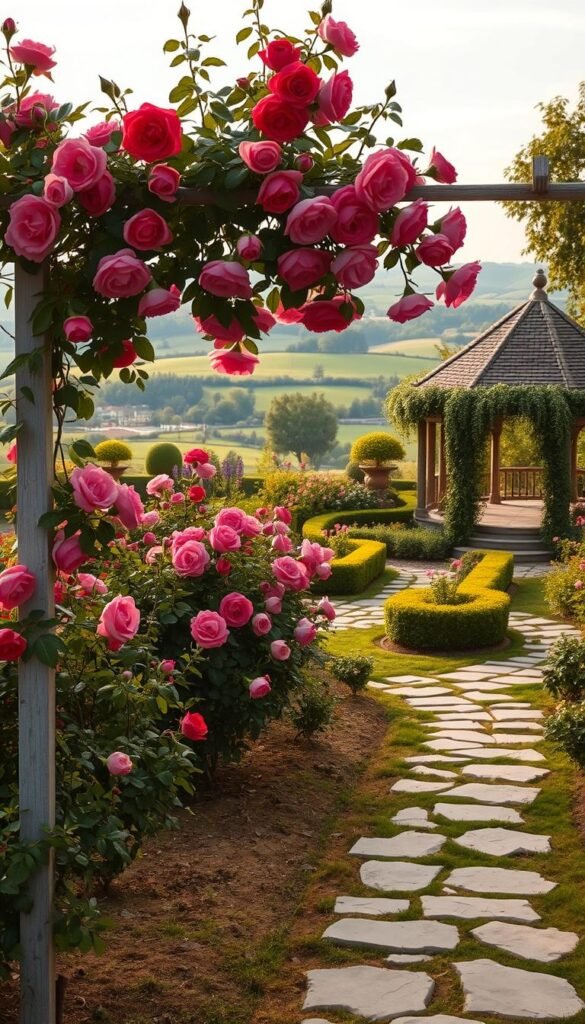Dreaming of a backyard retreat that feels like a page from a storybook? You don’t need endless acres or decades of expertise to craft a space bursting with color and fragrance. With thoughtful planning, even a modest corner can become a sanctuary where beauty and tranquility thrive.
Roses have captivated hearts for centuries, blending elegance with rugged adaptability. Their velvety petals and sweet scents make them ideal for creating intimate outdoor settings. Whether you prefer structured layouts or wild, cascading blooms, these flowers adapt effortlessly to your vision. Pair them with lavender or catmint for texture, or let them shine as standalone stars.
Discover how rose garden ideas can elevate your yard into a living work of art. From compact urban plots to sprawling estates, there’s a design approach for every space. Climbers like ‘Golden Celebration’ add vertical drama, while shrub varieties offer low-maintenance charm.
What makes these blooms so special? Beyond their looks, they invite pollinators and infuse your environment with life. Imagine sipping morning coffee surrounded by hummingbirds and butterflies—a reward for choosing plants that nurture nature.
Ready to start? This guide walks you through timeless concepts that balance practicality with romance. You’ll learn how to mix colors, textures, and layouts to create a space that feels uniquely yours—and keeps blooming joyfully year after year.
Essential Elements of a Romantic Rose Garden
Transform your yard into a living masterpiece by mastering layout fundamentals and plant partnerships. A well-planned space combines visual flow with practical growing conditions, creating an environment where beauty and function coexist.
Understanding Focal Points and Structured Layouts
Every captivating design needs an anchor. A statement piece—like a weeping standard rose or vintage fountain—draws attention while establishing rhythm. Arrange surrounding blooms in repeating color blocks or staggered heights to guide the eye naturally.
Structured layouts work best when they reflect your home’s style. Symmetrical beds suit formal architecture, while curved borders soften modern spaces. Always account for mature plant sizes to avoid overcrowding.
Mixing Varieties and Companion Plants
Combine climbers, shrubs, and groundcover types for layered interest. Early-blooming varieties paired with late-season performers ensure continuous color. Underplant with catmint or salvia to hide bare stems and attract pollinators.
Smart pairings boost plant health, too. Fragrant herbs like thyme deter pests, while tall grasses improve air circulation. Leave breathing room between bushes—18-24 inches prevents disease and lets each bloom shine.
Explore 10 Rose Garden Ideas for a Romantic and Timeless Display
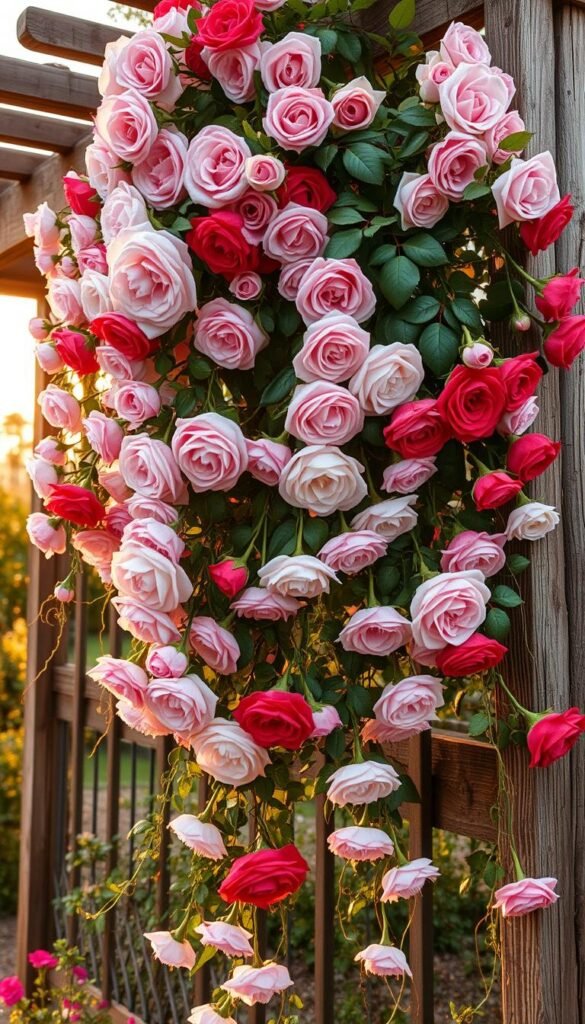
Looking to add vertical drama or soft cascades to your outdoor space? Let’s dive into creative ways to use three standout types that bring unique character to any landscape.
Vertical Wonders with Climbing Varieties
Turn bland walls into living art with climbing roses. These vigorous growers thrive on trellises, transforming fences into floral curtains. Try ‘New Dawn’ for pale pink repeats or ‘Don Juan’ for bold red blooms. They’re perfect for hiding AC units or creating shaded seating nooks.
Structured Beauty of Shrub Types
Shrub roses offer effortless charm as flowering hedges or standalone accents. Varieties like ‘Knock Out’ bloom nonstop with minimal care, while ‘Lady of Shalott’ dazzles with apricot hues. Space them 3 feet apart for lush borders that frame pathways beautifully.
Wild Elegance of Rambling Roses
For fairy-tale drapes over pergolas, nothing beats rambling roses. Unlike climbers, these flexible canes bend gracefully under their own weight. ‘The Albrighton Rambler’ showers arches with creamy clusters, while ‘Paul’s Himalayan Musk’ creates fragrant purple waterfalls.
Mix these types to play with height and texture. Pair ramblers with clematis for multi-season interest, or underplant shrubs with creeping thyme. Your space will buzz with pollinators while maintaining that coveted romantic vibe.
Cultivating the Timeless Charm of an English Garden
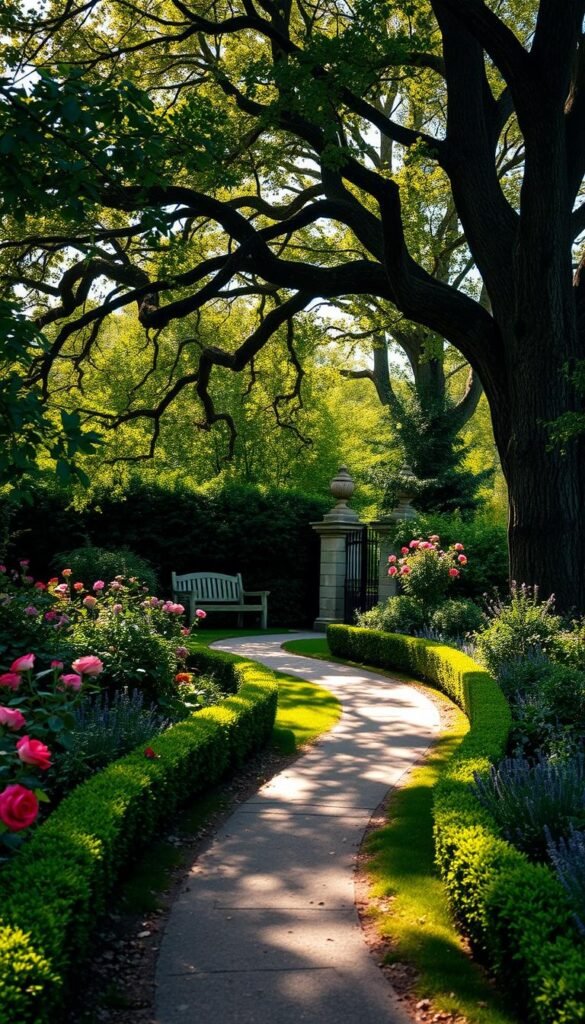
Ever wondered how English gardens maintain their allure through the seasons? The secret lies in blending order with spontaneity. Think clipped hedges framing bursts of blooms and winding paths inviting exploration. This style celebrates contrasts—where beauty thrives in both structure and wildness.
Defining Spaces with Living Architecture
Boxwood hedges are the backbone of classic designs, outlining flower beds and walkways with crisp lines. But you’re not limited to traditional choices. Inkberry holly offers glossy leaves and berry clusters, while lavender adds silvery foliage and pollinators. Each plant shapes your space differently:
| Plant | Height | Maintenance | Texture |
|---|---|---|---|
| Boxwood | 2-4 ft | Regular pruning | Dense, formal |
| Inkberry Holly | 3-6 ft | Low | Glossy, natural |
| Lavender | 1-3 ft | Minimal | Feathery, fragrant |
| Catmint | 1-2 ft | Easy-care | Soft, sprawling |
Pathways That Tell a Story
Crushed stone or weathered flagstone pathways guide visitors through your roses while adding rustic charm. Curve them around flowering clusters to create surprises—like a bench tucked under an arbor draped with climbers. These routes aren’t just practical; they frame views and slow down time.
Balance is key. Let roses spill over edges for that “lived-in” feel, but keep walkways clear. Underplant with thyme or sedum to soften hardscapes. Your garden becomes a living postcard—one that ages gracefully, season after season.
Designing a Cottage Garden with a Modern Twist
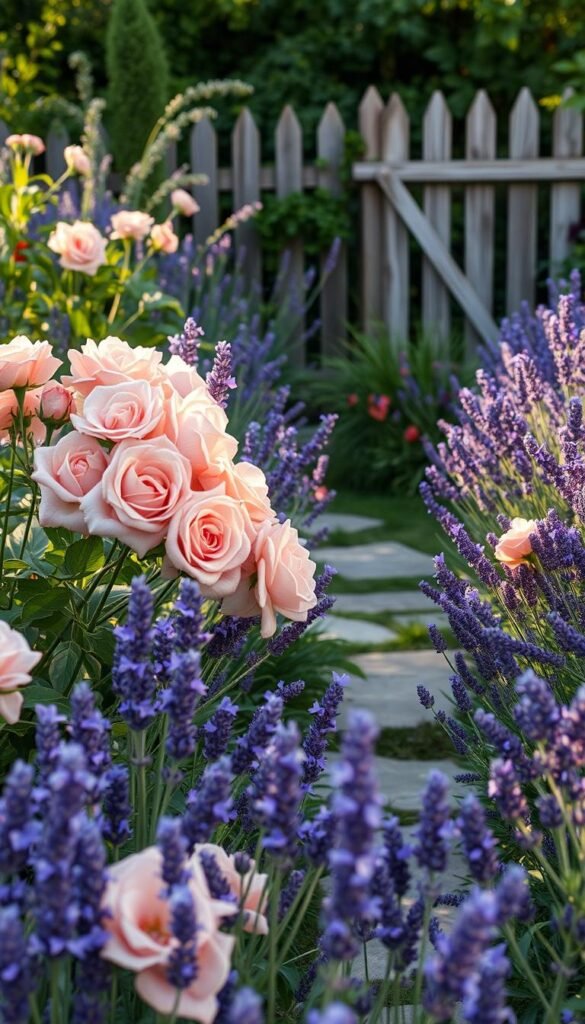
What if your outdoor space could blend vintage charm with today’s clean lines? Modern cottage style marries loose, flowing arrangements with intentional design choices. Think wildflower energy meets curated color palettes—a space that feels both effortless and thoughtfully composed.
Colorful Blooms Meet Fragrant Accents
Start with a base of repeat-blooming shrub roses like ‘Gertrude Jekyll’ or ‘The Mayflower’. Their soft pinks and reds pair beautifully with spiky blue salvias or feathery cosmos. Add vertical punches with foxgloves or delphiniums—their height creates drama without stiffness.
Fragrance layers the experience. Plant sweet peas near seating areas and underplant roses with lemon thyme. This combo releases scent when brushed against, turning every stroll into a sensory journey.
“A garden should feel like a favorite sweater—comfortable, lived-in, yet always inviting.”
Herbal Partnerships That Elevate Beauty
Lavender isn’t just pretty—it’s practical. Its silvery foliage contrasts with rose greens, while its scent deters aphids. Try English lavender varieties for compact growth or ‘Grosso’ for bold purple spikes.
| Companion Plant | Benefits | Bloom Time |
|---|---|---|
| Lavender | Pest control, fragrance | Late spring to summer |
| Catmint | Soft texture, drought-tolerant | Spring to fall |
| Yarrow | Attracts pollinators | Summer |
| Salvia | Color contrast, low maintenance | Late spring to frost |
For textural depth, mix rose canes with ornamental grasses like blue fescue. Their wispy blades catch sunlight beautifully, especially when elevating your space with a gardening. Remember—cottage style thrives on controlled chaos. Let clematis vines scramble through rose branches, creating unexpected moments of beauty.
Planning Your Outdoor Space for Year-Round Beauty
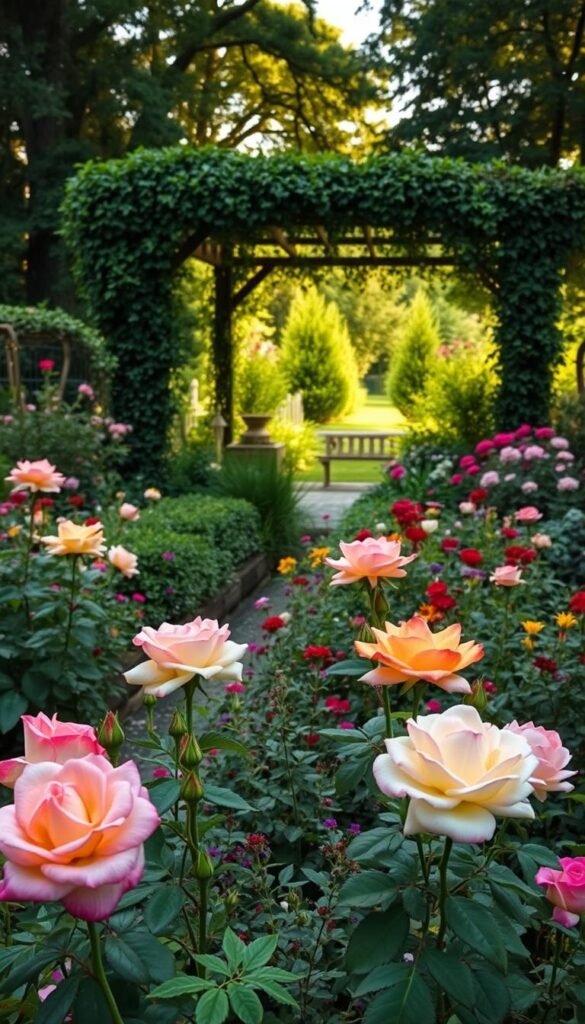
Creating a landscape that delights in every season starts with understanding your environment. Whether you’re working with a sprawling backyard or a cozy patio, thoughtful preparation ensures your efforts bloom into lasting rewards.
Assessing Sunlight, Soil, and Seasonal Blooms
Begin by tracking sunlight patterns. Most roses crave 6+ hours of direct sun daily. Use a free app or simple observations to map shaded versus sunny zones in your outdoor space.
Test your soil’s pH—roses thrive in slightly acidic conditions (6.0-6.5). If your ground is sandy or clay-heavy, mix in compost or aged manure. This improves drainage and nutrient retention, creating the ideal foundation for healthy roots.
Pair roses with early-spring bulbs like crocuses or daffodils. These pop up before roses leaf out, adding color when your garden needs it most. For summer-to-fall interest, consider colorful container gardening with annuals that complement your palette.
Balancing Formal and Informal Garden Areas
Define structured zones with boxwood hedges or low stone walls. These frames create order while letting flowering plants shine. Use symmetrical rose beds near seating areas for visual calm.
In less-trafficked corners, embrace wilder textures. Let rambling varieties spill over pathways, or plant native grasses that sway in the breeze. This mix of control and freedom keeps spaces dynamic yet cohesive.
Remember: Gardening isn’t about perfection. It’s crafting a living canvas that evolves with the seasons—and brings joy at every turn.
Creative Uses for Climbing Roses and Ramblers
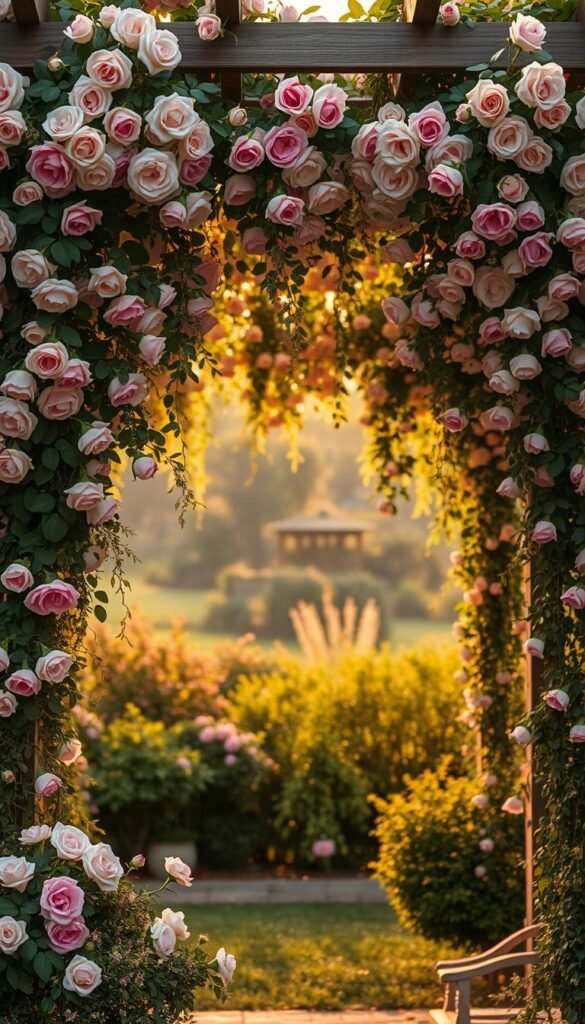
Picture a garden where roses don’t just bloom—they dance across structures, turning ordinary spaces into living art. Vertical surfaces become canvases for floral expression when you harness the potential of climbing roses and ramblers. These varieties breathe life into forgotten corners, creating moments of surprise and delight.
Training on Arbors, Pergolas, and Garden Walls
Start by selecting sturdy supports. Metal or cedar structures work best for heavy climbers like ‘New Dawn’. Gently tie stems to frames using soft twine, spacing them 8-12 inches apart. This encourages airflow and prevents tangled growth.
For a whimsical touch, train rambling roses through mature trees. The ‘Francis E. Lester’ variety shines here—its delicate pink blossoms cascade like floral confetti without overpowering branches. Just ensure your tree is healthy and at least 10 years old.
Doorways transform into fragrant portals when framed with blooms. Choose compact climbers like ‘Zéphirine Drouhin’ for arch entries. Their thornless stems make pruning safer, and their citrus scent welcomes guests naturally.
Pathways gain magic under rose-covered arches. Install curved metal supports along walkways, then let ramblers like ‘Snow Goose’ tumble overhead. Their white clusters create dappled shade that shifts with the sun, turning every stroll into an event.
Maximizing Small Spaces with Container Rose Gardens
Who says you need sprawling beds to enjoy nature’s most beloved blooms? Even the coziest balcony or narrow patio can burst with color when you harness the power of compact varieties. These space-savvy solutions let you curate breathtaking arrangements that rival traditional plots.
Choosing Patio and Miniature Varieties
Start with roses bred for tight quarters. Harlow Carr dazzles with cupped pink blossoms and a spicy scent, thriving in 18-inch pots. Princess Alexandra of Kent offers rich raspberry tones and tea fragrance in just 3 feet of height—ideal for flanking entryways.
| Variety | Height | Bloom Color | Special Features |
|---|---|---|---|
| Desdemona | 2.5 ft | Creamy white | Disease-resistant |
| Vanessa Bell | 3 ft | Soft yellow | Repeat flowering |
| Harlow Carr | 2 ft | Deep pink | Strong fragrance |
| Princess Alexandra | 3 ft | Rich pink | Compact growth |
Pair these stars with trailing lobelia or sweet alyssum in mixed containers. Their delicate foliage spills over edges, creating lush cascades. For vertical impact, train mini climbers like ‘Sweet Dreams’ on slim trellises—they’ll reach 6 feet without overwhelming your setup.
Success starts with the right foundation. Use pots with drainage holes and quality potting mix. Patio container gardening thrives when you water deeply but less frequently, encouraging strong roots. Feed every 4-6 weeks during growing season for nonstop blooms.
Your small-space oasis awaits. With smart plant choices and creative arrangements, you’ll transform overlooked corners into fragrant retreats that charm every passerby.
Innovative Layout Designs for Your Rose Garden
Your garden’s layout shapes how you experience its beauty. Whether you prefer crisp geometry or flowing curves, smart design choices create spaces that feel intentional yet welcoming. Let’s explore two distinct approaches to organizing your blooms.
Symmetrical Patterns Versus Organic Flow
Structured designs make bold statements. Think parterre beds with boxwood borders or concentric circles of hybrid tea roses. These patterns work well near patios or entryways, where clean lines complement architectural features.
For a relaxed vibe, try meandering borders. Let groundcover varieties spill over edges, softening hardscapes. This style suits sloped areas or woodland edges, creating a sense of discovery. As landscape designer Piet Oudolf notes:
“Gardens should whisper, not shout—inviting exploration through subtle surprises.”
| Feature | Symmetrical | Organic |
|---|---|---|
| Visual Impact | Formal, bold | Soft, natural |
| Maintenance | High | Moderate |
| Best For | Small spaces | Large yards |
| Companion Plants | Lavender, sage | Ferns, asters |
Creating Inviting Pathways and Viewing Points
Paths do more than guide feet—they frame views. Crushed granite walkways lined with dwarf roses lead eyes toward focal points like sundials or birdbaths. For hidden nooks, curve paths around mature shrubs.
Add seating where scents concentrate. A wrought-iron bench under an arch dripping with climbers becomes a sensory retreat. Remember: Your structured versus free-flowing approaches can coexist. Straight central paths paired with winding side routes offer both order and whimsy.
Integrating Color and Fragrance in Your Garden
Imagine stepping outside to a space where every glance and breath feels like a sensory celebration. Your outdoor area becomes an artist’s palette when you thoughtfully blend vivid hues and intoxicating scents. Let’s explore how to harmonize these elements for maximum delight.
Mastering Chromatic Conversations
Bold crimson blooms pop against sage-green foliage, while soft peach petals glow beside purple salvias. Color coordination transforms random plantings into cohesive displays. For drama, pair ‘Double Delight’ roses (cream with red edges) with deep purple irises. Want serenity? Combine blush-pink ‘Jude the Obscure’ with white cosmos.
Curating Nature’s Perfumery
Fragrant varieties like ‘Gertrude Jekyll’ release old-rose scent all day, perfect near benches. Plant ‘Honey Perfume’ along walkways—its apricot notes intensify at dusk. Pro tip: Cluster aromatic flowers where breezes carry their perfume. A seating nook flanked by lemon thyme and ‘Mister Lincoln’ roses becomes an open-air spa.
Balance is key. Too many strong scents overwhelm, while monochromatic schemes feel flat. Mix heights and bloom times for evolving beauty. Your garden will captivate eyes and noses from first bud to final petal drop.

